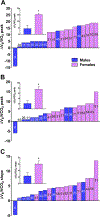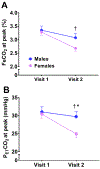Exercise testing in patients with cystic fibrosis-importance of ventilatory parameters
- PMID: 30357514
- PMCID: PMC6344248
- DOI: 10.1007/s00421-018-4018-5
Exercise testing in patients with cystic fibrosis-importance of ventilatory parameters
Abstract
Background: Ventilatory parameters obtained during exercise predict survival in several chronic diseases; however, long-term changes in exercise ventilatory parameters in patients with cystic fibrosis (CF) have yet to be examined and potential differences between sexes in CF are unknown.
Purpose: We sought to examine the change in exercise ventilatory parameters over time in patients with CF and determine if the change is different between sexes.
Methods: Exercise capacity (VO2 peak) and exercise ventilatory parameters (VE/VO2 peak, VE/VCO2 peak, and VE/VCO2 slope) were determined from a maximal cardio-pulmonary test on a cycle ergometer on two visits separated by 39 ± 16 months in 20 patients with CF (10 female, 10 male).
Results: No differences between sexes were observed at visit 1 (all p > 0.05). Overall, exercise ventilatory parameters significantly (p < 0.05) deteriorated between visits, with no change (p > 0.05) in VO2 peak. Moreover, compared to males, female patients exhibited greater deteriorations in VE/VO2 peak (p = 0.001), VE/VCO2 peak (p = 0.002), and VE/VCO2 slope (p = 0.016) between visits.
Conclusions: These data in patients with CF indicate that exercise ventilatory parameters decline over time despite no change in VO2 peak, and female patients exhibit a more rapid deterioration compared to males.
Keywords: Exercise capacity; Pulmonary function; Ventilatory efficiency.
Conflict of interest statement
Competing Interest
None to declare.
Figures



References
-
- American Thoracic Society (1995) Standardization of Spirometry, 1994 Update. American Thoracic Society. American journal of respiratory and critical care medicine 152 (3):1107–1136 - PubMed
-
- Beaver WL, Wasserman K, Whipp BJ (1986) A new method for detecting anaerobic threshold by gas exchange. Journal of applied physiology 60 (6):2020–2027 - PubMed
-
- Cantin A (1995) Cystic fibrosis lung inflammation: early, sustained, and severe. American journal of respiratory and critical care medicine 151 (4):939–941 - PubMed
-
- Cohen J (1988) Statistical power analysis for the behavioral sciences . Hilsdale. NJ: Lawrence Earlbaum Associates 2
-
- Corey M, Levison H, Crozier D (1976) Five-to Seven-Year Course of Pulmonary Function in Cystic Fibrosis 1–3. American Review of Respiratory Disease 114 (6):1085–1092 - PubMed

